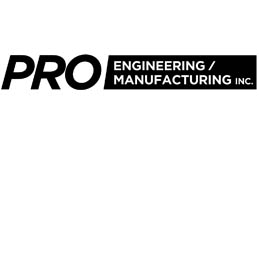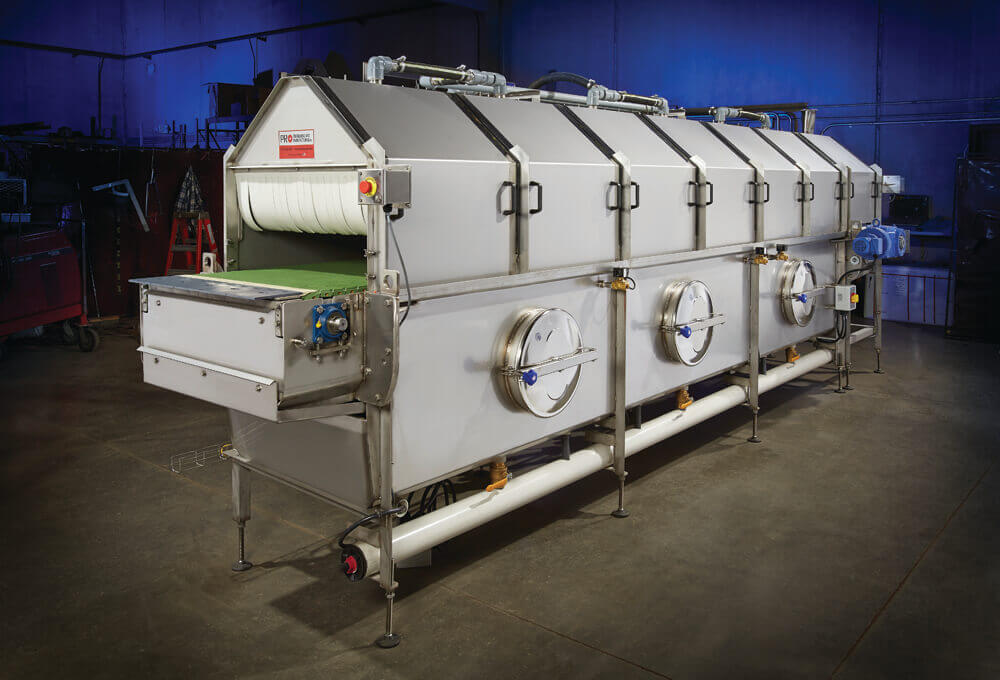A Basic Guide to Purchasing and Using Tunnel Pasteurizers
By Edward A. Michalski
CEO
PRO Engineering/Manufacturing, Inc.
Tunnel pasteurizers are efficient and effective machines that are available in numerous sizes. The food and beverage industries use them to kill microbes, stop fermentation and in general, provide shelf stability.
These machines are subject to significant heat variations, caustic cleaning chemicals, steam, water, huge mechanical stresses and in many applications, broken bottles.
PRO Engineering/Manufacturing, Inc. has been maintaining, repairing and re-engineering tunnel pasteurizers for over four decades. PRO designs and builds our own tunnel pasteurizers and refurbishes competitor’s machines.
There are different types of tunnel pasteurizers classified by the mechanism that moves the pasteurized product through the tunnel.
Walking Beam
This is an older configuration that employs alternating strips, picking and stepping product forward. Most of these machines are being re-engineered into belt pasteurizers.
Belt
This is a newer design that uses stainless steel or plastic mats/belts. The Mid 90’S transition away from walking beam saw the advent of perforated plastic belts, wire mesh belts and hybrid versions. (plastic and metal combinations)
Carrier
These are formed carrier channels that are mounted to roller chains on each side. The channels support the product and transfers it through the tunnel.
SlimLine Tunnel Pasteurizer
(Small Tunnel Pasteurizer)
Next, let’s look at the areas/sections of a tunnel pasteurizer.
Infeed
This is the area at the entrance to the machine. It can be problematic if the infeed conveyor does not hand off the bottles/cans to the mat/belt effectively.
Sump
The area under the belt that catches the water after it has flowed over the cans/bottles/packages that contain the product being pasteurized. The quality of the bottles can be a factor in the amount of bottle breakage. If breakage occurs, the material can be captured in the sump or continue to move out and drop off from the discharge conveyor.
Watertight Access Ports
These openings are watertight ports positioned on the side of the tunnel to give maintenance workers access to the belt and/or the sump for cleaning or service.
Zones
The tunnel is divided into multiple zones from the front to the back of the machine. The zones have spray nozzles or drip pans inside them, at the top of each zone. The various zones spray water at different temperatures to warm and cool the product being pasteurized.
Pasteurization Units
Although not a part of the pasteurizer, pasteurization units, are an integral part of operating a pasteurizer correctly. Abbreviated as PUs, pasteurization units are a measure of the amount of time and temperature a food or beverage has been subjected to, in order to kill off microbes and deactivate yeast cells. The pasteurization units are equal to 1 PU when the product is exposed to 60°C (140°F) for one minute Depending on the type of food or beverage, the PUs required for appropriate pasteurization varies.
Pasteurization Unit Monitor
A pasteurization unit monitor performs the function of monitoring the PUs (pasteurization units) that the beverage or food has been subjected to during its ride through the pasteurizer. The monitor is a system that consists of hardware and software. The hardware travels on the belt with the product being pasteurized. After the trip is finished, the hardware downloads the measurements of time and temperature to a laptop computer and the PUs are calculated.
Controls
PLC-based controls that use an HMI (Human Machine Interface) are standard. The PLC will have numerous programs available to be loaded in it that control the water sprays inside the tunnel. Time and temperature are varied depending on the product being pasteurized.
Discharge Area
The discharge is at the back of the tunnel pasteurizer. At this point, the bottles/cans are transferred from the internal mat/belt to the external conveyor. A good hand-off is required.

PRO/Line Series 5 Tunnel Pasteurizer
(Medium Sized Tunnel Pasteurizer)
Heat Recovery System
The main component of the heat recovery system is the heat exchanger. The heat recovery system takes heat from containers (bottles and cans are most common) at the discharge end of the tunnel by circulating water used to heat the containers and sending the hot water to the infeed end of the machine to start to heat the containers at the beginning of the pasteurizing process.
There are various types and configurations of heat exchangers:
Plate Configuration Heat Exchangers
- Advantages:
- Single, larger plate version can supply all the needed energy
- Disadvantages:
- Requires shielding from possible steam leakage
- More expensive to clean and maintain
Tube and Bundle Heat Exchangers
- Advantages:
- Very efficient heat transfer
- Easy cleaning by CIP
- Disadvantages:
- Multiple units are required
Heat Sources
Boilers
Low-Pressure Steam
-
- Advantages:
- This option doesn’t a need licensed boiler operator/Less cost
- Disadvantages:
- Much slower heat transfer occurs
- Advantages:
High-Pressure Steam
-
- Advantages:
- Faster heat transfer
- Disadvantages:
- Need licensed boiler operator
- Regulated by local authorities
- Advantages:
Super-heated Hot Water
-
- Advantages:
- More efficient heat delivery than low steam
- Doesn’t need as many components as steam to return condensate to boiler.
- Disadvantages:
- Regulated by local authorities
- Advantages:
PRO/Line Series 14
(Large Tunnel Pasteurizer)
Spray Nozzles
Nozzle sizes
- Large orifice (reduced clogging) (more expensive)
- Large Orifice Nozzle Versions
- Low flow, large droplets
- High flow, large droplets
- Large Orifice Nozzle Versions
- Small orifice (less expensive) (prone to clogging)
- Small Orifice Nozzle Versions
- Low flow, high velocity
- Small Orifice Nozzle Versions
Spray Pans
- Easy to clean
- Prone to clogging
- Version
- High flow, low velocity
Belts/Mats
- Plastic
- (easy to install) (light weight) (lower initial cost, higher operating cost) (prone to chemical attack) (lower maximum temperature) (easier to break) (require frequent maintenance) (shorter life cycle) (susceptible to UV attack)
- Stainless Steel
- (Higher initial cost) (longer life cycle) (greater chemical resistance) (broader temperature range) (reduced maintenance) (lower operational cost)
Guides
- Commercially Available Product Guides
- (Readily obtainable) (market priced)
- (easier installation) (good for bottles and cans)
- Stainless Steel Guide Plates
- (Good for bottle lines) (poor for cans)
- (low maintenance) (long life)
Fabricated Plastic Side Guides
- Various plastics are available
- Various levels of chemical resistance are offered
- More chemical resistance equals less physical flexibility
- Susceptible to UV attack
- Flexible plastics-good for can lines, fair for bottle lines
- Higher temperature rigid plastics available
Pasteurization Unit (PU) Monitor Hardware and Software
Results displayed on Separate Laptop
SUMMARY
This is a basic guide that you can use when considering the purchase or the operation of a tunnel pasteurizer. PRO Engineering/Manufacturing has been refurbishing, designing and building tunnel pasteurizers for over 40 years. We offer the widest variety of small, medium and large sized tunnel pasteurizers along with batch pasteurizers. Contact us to learn more!
For more information on tunnel and batch pasteurization contact PRO Engineering/Manufacturing, Inc. at [email protected] or call (414) 362-1500 and ask for Ed Michalski, CEO.
Edward A. Michalski Bio
Ed Michalski started his career in the beverage industry by designing stainless steel, higher flow, spray headers for Pabst Brewing. Along with the header design he also developed a process to produce the new headers.
Ed, along with his brother David, formed PRO Engineering/Manufacturing, Inc.
Based on what they learned by re-designing and refurbishing other manufacturers’ pasteurizers, Ed and PRO started to offer the pasteurizer marketplace superior new pasteurizers.
PRO Engineering/Manufacturing has been designing and manufacturing great pasteurizers for over four decades.

ABOUT US:
PRO Engineering and Manufacturing was established in 1977 by Ed and Dave Michalski as a steel fabrication shop. For more than 40 years, PRO Engineering and Manufacturing, Inc. has been delivering solutions for beverage product shelf stability and consumption safety. As leading innovators in post-fill pasteurization, our skilled team offers the best in high-quality pasteurization equipment.
CONTACT US:
Phone: 414-362-1500 | Email: [email protected]
Previous Article: BATCH AND TUNNEL PASTEURIZATION FOR CIDER/HARD CIDER PRODUCTION




